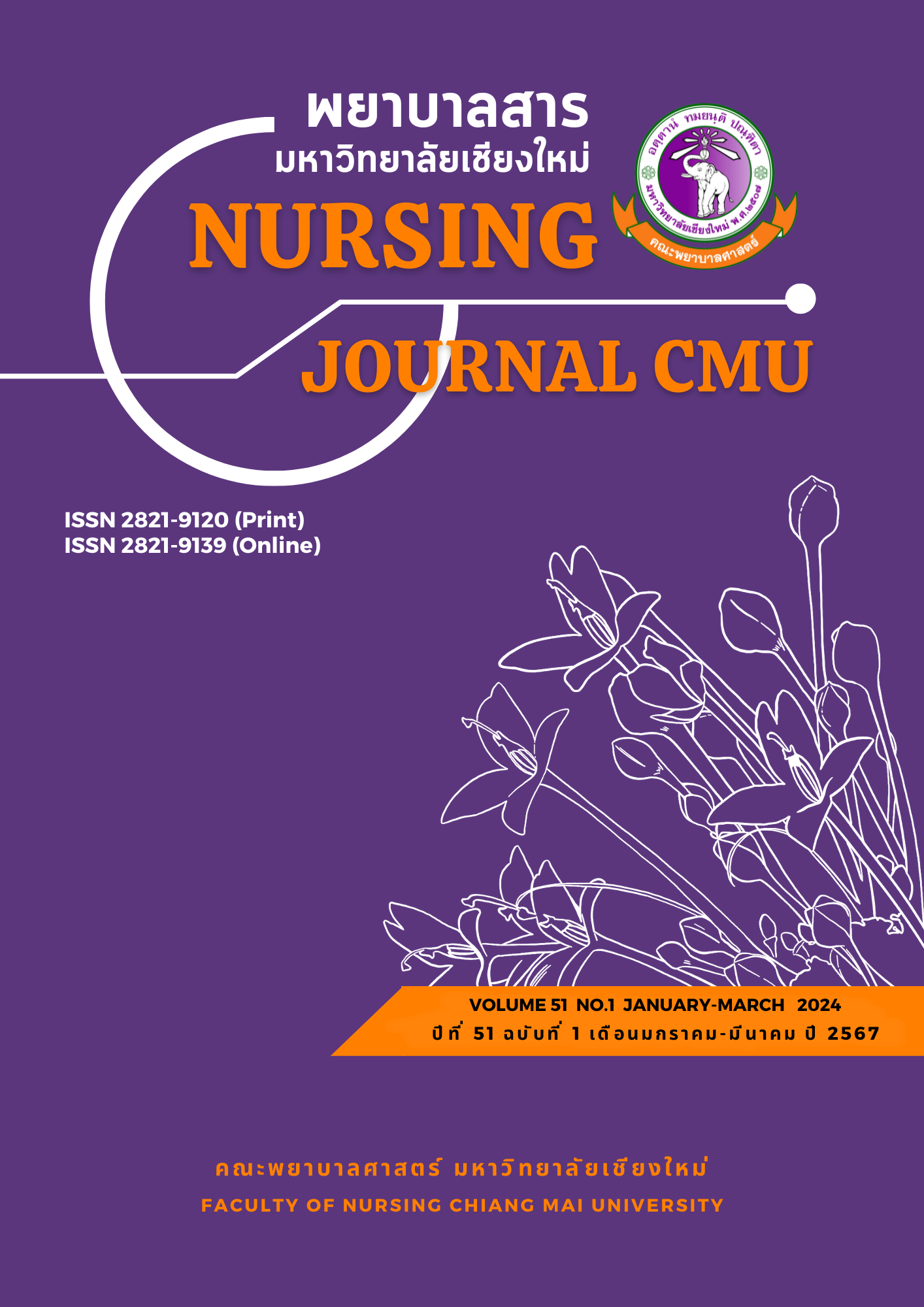Interpreting Arterial Blood Gas and the Role of Nurses in Caring for Patients with Abnormal Arterial Blood Gas
Keywords:
Arterial blood gas, Interpretation of arterial blood gas, Acid–base balance, Role of nursesAbstract
Abnormalities in the body's acid-base balance can lead to critical complications. In certain cases, the irregularity is so severe that it poses a life-threatening risk to the patient. Nurses must be able to do arterial blood gas (ABG) analysis. The objectives of this article are to: 1) present the physiological basis for arterial blood gas evaluation; 2) present a systematic 5-step blood gas analysis method; and 3) present the role of nurses in caring for patients with abnormal arterial blood gas values. The steps in evaluating and analyzing arterial blood gases consist of determining: 1) the partial pressure of O2 in arterial blood; 2) the concentration of hydrogen ions; 3) the respiratory and metabolic components; 4) whether the respiratory or metabolic value is consistent with the pH value; and 5) whether compensation is present. Three case scenarios are also provided to assist the reader in practicing ABG interpretation. The ability to reliably assess ABGs enables nurses to assist in restoring a patient's acid-base balance.
References
Adrogué, H. J., & Madias, N. E. (2020). Alkali therapy for respiratory acidosis: A medical controversy. American Journal of Kidney Diseases, 75(2), 265-271.
Achanti, A., & Szerlip, H. M. (2023). Acid-base disorders in the critically ill patient. Clinical Journal of the American Society of Nephrology: CJASN, 18(1), 102–112. https://doi.org/10.2215/CJN.04500422
Brabrand, M. (2022). Arterial blood gas analysis: As safe as we think? A multicentre historical cohort study. ERJ Open Research, 8(1). 1-11.
Byrne, D., & Laske, A. (2022). Arterial blood gases: An easy guide to analysis. Nursing Made Incredibly Easy, 20(1), 11-13.
Calimag, A. P. P., Chlebek, S., Lerma, E. V., & Chaiban, J. T. (2023). Diabetic ketoacidosis. Disease-a-Month, 69(3), 101418. https://doi.org/10.1016/j.disamonth.2022.101418
Chandran, J., D'Silva, C., Sriram, S., & Krishna, B. (2021). Clinical utility of arterial blood gas test in an intensive care unit: An observational study. Indian Journal of Critical Care Medicine, 25(2), 172-175. https://doi.org/10.5005/jp-journals-10071-23719
Do, C., Vasquez, P. C., & Soleimani, M. (2022). Metabolic alkalosis pathogenesis, diagnosis, and treatment: Core curriculum 2022. American Journal of Kidney Diseases, 80(4), 536-551.
Duska, F., Mo, A.-H., & Maurizio, C. (2023). Interpreting blood gas analysis. Intensive care fundamentals: Practically oriented essential knowledge for newcomers to ICUs (pp. 127-138). Springer International Publishing.
Emmett, M. (2020). Metabolic alkalosis: A brief pathophysiologic review. Clinical Journal of the American Society of Nephrology, 15(12), 1848-1856.
Hamid, O. Y., & Abed, N. A. N. (2022). Disorder of acid-base balance in ESRD and its relation with some biochemical variables. HIV Nursing, 22(2), 1120-1124.
Hopkins, E., Sanvictores, T., & Sharma, S. (2022). Physiology, acid base balance. StatPearls Publishing.
Hughes, J. M., Vilchiz, V. H., & Lee, C. (2021). An easy approach to understanding acid-base balance in a blood buffer system. The American Biology Teacher, 83(8), 526-531.
Ibrahem, S. E., Morsy, W. Y. M., Mohamed, R. B., & Seloma, Y. A. E. (2021). Arterial blood gases interpretation: Critical care nurses’ knowledge and practices at a University Hospital−Kafr-elsheikh Governorate. Egyptian Nursing Journal, 18(3), 120-129.
Kim, H. J. (2021). Metabolic acidosis in chronic kidney disease: Pathogenesis, clinical consequences, and treatment. Electrolytes & Blood Pressure: E & BP, 19(2), 29-37.
Messina, Z., & Patrick, H. (2022). Partial pressure of carbon dioxide. StatPearls Publishing.
Mittal, K., Aggarwal, H., Rungta, N., & Patki, V. (2021). Respiratory acidosis and alkalosis. Journal of Pediatric Critical Care, 8(3), 161. https://doi.org/10.4103/jpcc.jpcc_20_21
Muneer, M., & Akbar, I. (2021). Acute metabolic emergencies in diabetes: DKA, HHS and EDKA. Advances in Experimental Medicine and Biology, 1307, 85-114. https://doi.org/10.1007/5584_2020_545
Palmer, B. F., & Clegg, D. J. (2023). Respiratory acidosis and respiratory alkalosis: Core curriculum 2023. American Journal of Kidney Diseases, 82(3), 347-359.
Pandit, R., & Pundpal, G. S. (2020). Arterial blood gases. In R. Chawla & S. Todi (Eds.), ICU protocols: A step-wise approach, Vol II. (pp.33-43). Springer International Publishing. https://doi.org/10.1007/978-981-15-0902-5_4
Pippalapalli, J., & Lumb, A. B. (2023). The respiratory system and acid–base disorders. BJA Education, 23(6), 221-228.
Quade, B. N., Parker, M. D., & Occhipinti, R. (2021). The therapeutic importance of acid-base balance. Biochemical Pharmacology, 183, 114278. https://doi.org/10.1016/j.bcp.2020.114278
Rodríguez-Villar, S., Do Vale, B. M., & Fletcher, H. M. (2020). The arterial blood gas algorithm: Proposal of a systematic approach to analysis of acid-base disorders. Revista Española de Anestesiología y Reanimación (English Edition), 67(1), 20-34.
Thangaraj, R. K., Chidambaram, H. H. S., Dominic, M., Chandrasekaran, V. P., Padmanabhan, K. N., & Chanjal, K. S. (2021). A comparison of arterial and venous blood gas analysis and its interpretation in emergency department: A cross-sectional study. Eurasian Journal of Emergency Medicine, 20(3), 178-182.
Tinawi, M. (2021). Respiratory acid-base disorders: Respiratory acidosis and respiratory alkalosis. Archives of Clinical and Biomedical Research, 5(2), 158-168.
Viterbo, L., Hughes, J., Milner, P. I., & Bardell, D. (2023). Arterial blood gas, electrolyte and acid-base values as diagnostic and prognostic indicators in equine colic. Animals, 13(20), 3241. https://doi.org/10.3390/ani13203241
Wagner, C. A., Imenez Silva, P. H., & Bourgeois, S. (2019). Molecular pathophysiology of acid-base disorders. Seminars in Nephrology, 39(4), 340-352. https://doi.org/10.1016/j.semnephrol.2019.04.004
Wilcox, S. R., Aydin, A., & Marcolini, E. G. (2022). Blood gas analysis. Mechanical ventilation in emergency medicine (2nd ed., pp. 27-29). Springer International Publishing. https://campus.com.pe/wp-content/uploads/2022/10/Mechanical-ventilation-in-emergency-medicine-2nd-edition_demo.pdf
Wongprakornkul, S. (2022). Easy interpretation of arterial blood gases. Journal of Sakon Nakhon Hospital, 23(3), 111-119. (in Thai)
Yagi, K., & Fujii, T. (2021). Management of acute metabolic acidosis in the ICU: Sodium bicarbonate and renal replacement therapy. Critical Care, 25, 314. https://doi.org/10.1186/s13054-021-03677-4
Yee, J., Frinak, S., Mohiuddin, N., & Uduman, J. (2022). Fundamentals of arterial blood gas interpretation. Kidney360, 3(8), 1458–1466. https://doi.org/10.34067/KID.0008102021
Downloads
Published
How to Cite
Issue
Section
License
Copyright (c) 2024 Nursing Journal CMU

This work is licensed under a Creative Commons Attribution-NonCommercial-NoDerivatives 4.0 International License.
บทความที่ได้รับการตีพิมพ์เป็นลิขสิทธิ์ของวารสารพยาบาลสาร
ข้อความที่ปรากฏในบทความแต่ละเรื่องในวารสารวิชาการเล่มนี้เป็นความคิดเห็นส่วนตัวของผู้เขียนแต่ละท่านไม่เกี่ยวข้องกับมหาวิทยาลัยเชียงใหม่ และคณาจารย์ท่านอื่นๆในมหาวิทยาลัยฯ แต่อย่างใด ความรับผิดชอบองค์ประกอบทั้งหมดของบทความแต่ละเรื่องเป็นของผู้เขียนแต่ละท่าน หากมีความผิดพลาดใด ๆ ผู้เขียนแต่ละท่านจะรับผิดชอบบทความของตนเองแต่ผู้เดียว






